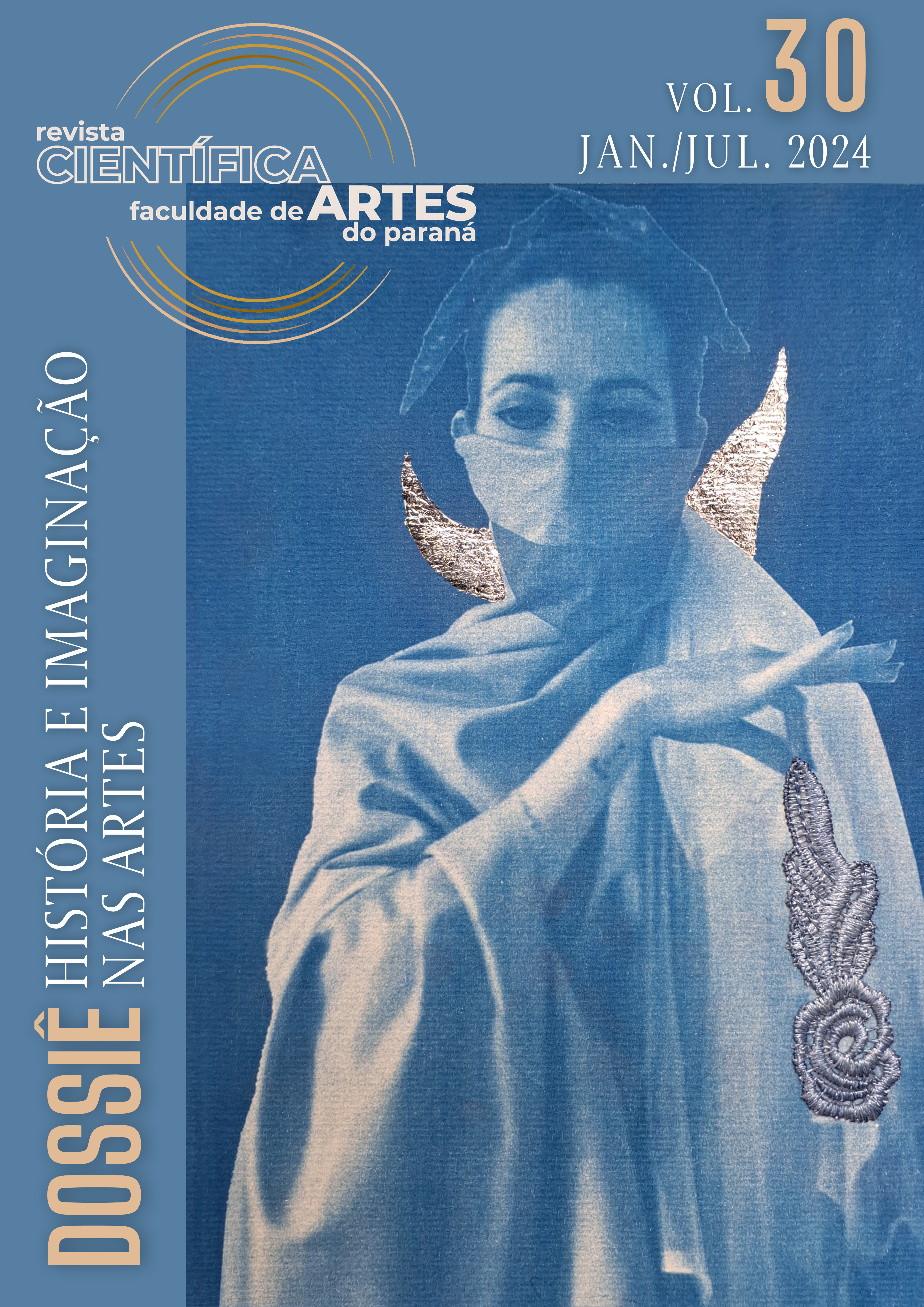Imaginação de dentro para fora, de fora para dentro
uma introdução à prática da imaginação nos trabalhos de Stanislavski e Chekhov
DOI:
https://doi.org/10.33871/19805071.2024.30.1.8717Keywords:
Imaginação; Gaston Bachelard; Henry Corbin; Konstantin Stanislavski; Michael Chekhov.Abstract
This article aims to bring some ways of understanding imagination, mainly through reading the works of philosophers Gaston Bachelard and Henry Corbin. These perspectives will then be articulated with the place occupied by imagination in the performing arts. To this end, the imagination in the work of Konstantin Stanislavski will be analyzed, through elements such as “the given circumstances”, the “magic if” and the “film of images” and in the practice of Michael Chekhov, with strategies and concepts such as the “psychological gesture” and the “imaginary body”.
Downloads
References
ANAZ, Sílvio Anaz; AGUIAR, Grazyella; LEMOS, Lúcia; FREIRE, Norma; CO/STA Edwaldo. Noções do Imaginário: Perspectivas de Bachelard, Durand, Maffesoli e Corbin. Revista Nexi, n.3, 2014. Não paginado.
ARTAUD, Antonin. O teatro e seu Duplo. 3 ed. São Paulo: Martins Fontes, 2006.
BACHELARD, Gaston, Poética do Espaço. In: Os Pensadores. São Paulo: Abril Cultural, 1978.
______. A água e os sonhos: ensaios sobre a imaginação da matéria. São Paulo: Martins Fontes, 1998.
BAITELLO, Norval; WULF, Christoph. Emoção e Imaginação: Os Sentidos e as Imagens em movimento. São Paulo: Estação das Letras e Cores, 2014.
BERNIS, Jeanne. A imaginação: Do sensualismo epicurista à psicanálise. Rio de Janeiro: Zahar, 1987.
CHEKHOV, Michael. Para o ator. 3 ed. São Paulo: Martins Fontes, 2003.
CORBIN, Henry. Creative Imagination in the Sufism of Ibn’Arabi. Princeton: Princeton University Press, 2014.
______. Mundus imaginalis or the imaginary and the imaginal (1972). Disponível em: http://imagomundi.com.br/espiritualidade/mundus_imaginalis.pdf. Acesso: 20 de abril 2018.
DAMÁSIO, Antonio. O mistério da consciência: do corpo e das emoções ao conhecimento em si, São Paulo: Companhia das Letras, 2015.
DURAND, Gilbert. A Imaginação Simbólica, Lisboa: Edições 70, 1995.
FEDERICI, Silvia. Calibã e A Bruxa: Mulheres, Corpo e Acumulação Primitiva. 1ed. São Paulo: Editora Elefante, 2017.
KNEBEL, Maria. Análise-ação: Práticas das ideias teatrais de Stanislávski. 1 ed. São Paulo: Editora 34, 2016.
MARTINS, Leda Maria. Seminário de Estudos da encenação possível/outro teatro: o ritual e o teatro das origens. Realização NEPAA/UNIRIO, 23 de setembro de 2020. Disponível em: https://youtu.be/VWhmMtoxRaI. Acesso em: 25 jan. 2023.
MERLIN, Bella. Beyond Stanislavski: The approach to Actor Training. Nova York: Routledge, 2001.
NÖE, Alva. Action in Perception. Massachusetts: MIT Press, 2004.
QUIJANO, Aníbal. Colonialidad del poder e clasificación social. Págs. 285-327 in El giro decolonial: reflexiones para una diversidad epistémica más allá del capitalismo global, CASTRO-GÓMEZ, Santiago y GROSFOGUEL, Ramón (orgs.) Bogotá: Siglo del Hombre, 2007.
SACHS, Cláudia Muller. A imaginação é um músculo: a contribuição de Lecoq para o trabalho do ator. 2013. Tese (Doutorado em Teatro) - Universidade do Estado de Santa Catarina, Florianópolis, 2013.
SIMONDON, Gilbert. Imaginación e Invención. 1 ed. Buenos Aires: Cactus, 2013.
SOLOMON, Richard. Michael Chekhov And His Approach to Acting In Contemporary Performance Training. Tese. (Master of Arts) - University of Maine.1983.
STANISLAVSKI, Konstantin. A preparação do ator. 24 ed. Rio de Janeiro: Civilização Brasileira, 1999.
______. Minha Vida na Arte. Rio de Janeiro: Civilização Brasileira, 1989.
______. El Trabajo del Actor sobre Sí Mismo: en el proceso creador de la vivencia. 2 ed. Barcelona: Alba Editorial, 2007.
ZINDER, David. The actor imagines with his body – Michael Chekhov: An examination of the phenomenon. Contemporary Theatre Review, v.17, p. 7-14, 2007.
Downloads
Published
How to Cite
Issue
Section
License
The authors retain the copyright, when licensing their production in Revista Científica/FAP, which is licensed under a Creative Commons license. When submitting the article, and upon acceptance, the author assigns his copyright for publication in that journal.
Readers can download, print and use the articles published in the journal, as long as there is always an explicit mention of the author (s) and the Revista Científica/FAP, no changes to the original work are allowed. When submitting an article to Revista Científica/FAP and after its being accepted for publication, the authors allow, without remuneration, to pass the following rights to the Journal: the first edition rights and the authorization for the editorial team to transfer, according to their judgment, this article and its metadata to indexing and reference services.


